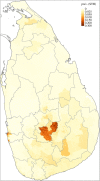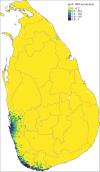Lymphatic filariases and soil-transmitted helminthiases in Sri Lanka: the challenge of eliminating residual pockets of transmission
- PMID: 37598710
- PMCID: PMC10440162
- DOI: 10.1098/rstb.2022.0280
Lymphatic filariases and soil-transmitted helminthiases in Sri Lanka: the challenge of eliminating residual pockets of transmission
Abstract
Sri Lanka has successfully met the challenge of controlling both lymphatic filariasis (LF) and soil-transmitted helminthiases (STH) as public health problems. The primary public health strategy for combatting both conditions has been preventive chemotherapy. The national programme for the elimination of LF implemented five annual rounds of mass chemotherapy in the endemic districts from 2002 to 2006 using a combination of diethylcarbamazine and albendazole. The overall microfilaria rate declined from 0.21% in 2001 before the mass chemotherapy, to 0.06% in 2016, at declaration of elimination of LF as a public health problem by the World Health Organization. Currently Sri Lanka is in the phase of post-validation surveillance. Achieving control of STH has been more difficult. Mass deworming programmes have been implemented for nearly a century, and national-level surveys reported prevalence rates declining from 6.9% in 2003 to 1% in 2017. However, neither of these infections has been completely eliminated. A situation analysis indicates continued transmission of both among high-risk communities. This paper explores the reasons for persistence of transmission of both LF and STH in residual pockets and the measures that are required to achieve long-term control, or perhaps even interrupt transmission in Sri Lanka. This article is part of the theme issue 'Challenges and opportunities in the fight against neglected tropical diseases: a decade from the London Declaration on NTDs'.
Keywords: control strategies; elimination as a public health problem; interruption of transmission; lymphatic filariasis; soil-transmitted helminthiasis.
Conflict of interest statement
We declare that we have no competing interests.
Figures



References
-
- Abdulcader MH, Sasa M. 1966. Epidemiology and control of bancroftian filariasis in Ceylon. Jpn J. Exp. Med. 36, 609-646. - PubMed
-
- Uragoda CG. 1987. A history of medicine in Sri Lanka: from the earliest times to 1948. Colombo, Sri Lanka: Sri Lanka Medical Association.
-
- World Health Organization. 2000. Preparing and implementing a national plan to eliminate lymphatic filariasis (in countries where onchocerciasis is not co-endemic), WHO/CDS/CPP/CEE 200016. Geneva, Switzerland: World Health Organization.
Publication types
MeSH terms
Substances
Associated data
LinkOut - more resources
Full Text Sources
Miscellaneous
